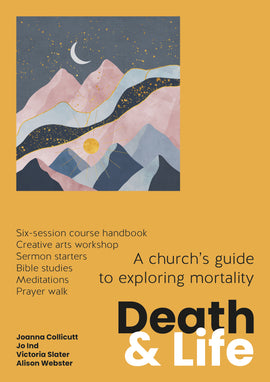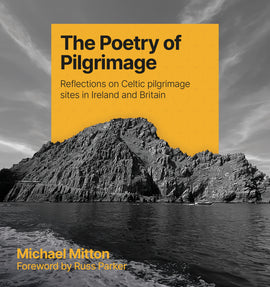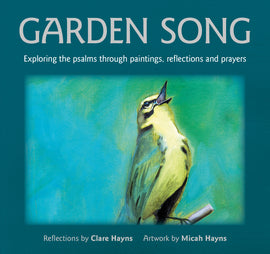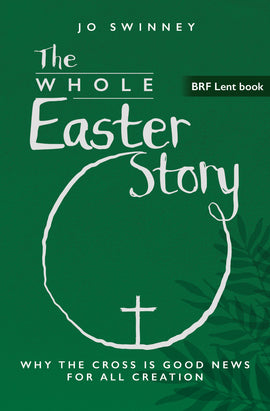Reimagining the Landscape of Faith: Essential pathways for spiritual growth
Spiritual direction in a book, creating a reflective space to grow in faith
Is this all there is to faith? Every Christian carries a map, a mental image of their journey through life, created from their Christian tradition, their cultural background and their understanding of the Bible. Most Christians will also, at some point in their life, begin to question their map – causing them to ask, ‘Is this all there is?’ and ‘How did I get here?’ Mary and Charles Hippsley help us to identify our faith map, including the unexamined assumptions that underpin it. Then, drawing on a range of sources of wisdom including personal experience, they gently encourage us to allow God to expand our map when we find that our faith doesn’t match up with the reality of life. They aim to equip the reader to navigate their journey towards maturity by exploring new paths and landscapes of faith.
| Title | Reimagining the Landscape of Faith: Essential pathways for spiritual growth |
| Author | Mary Hippsley and Charles Hippsley |
| ISBN | |
| Description | Is this all there is to faith? Every Christian carries a map, a mental image of their journey through life, created from their Christian tradition, their cultural background and their understanding of the Bible. Most Christians will also, at some point in their life, begin to question their map – causing them to ask, ‘Is this all there is?’ and ‘How did I get here?’ Mary and Charles Hippsley help us to identify our faith map, including the unexamined assumptions that underpin it. Then, drawing on a range of sources of wisdom including personal experience, they gently encourage us to allow God to expand our map when we find that our faith doesn’t match up with the reality of life. They aim to equip the reader to navigate their journey towards maturity by exploring new paths and landscapes of faith. |
| Details |
|
Is this all there is to faith? Every Christian carries a map, a mental image of their journey through life, created from their Christian tradition, their cultural background and their understanding of the Bible. Most Christians will also, at some point in their life, begin to question their map – causing them to ask, ‘Is this all there is?’ and ‘How did I get here?’ Mary and Charles Hippsley help us to identify our faith map, including the unexamined assumptions that underpin it. Then, drawing on a range of sources of wisdom including personal experience, they gently encourage us to allow God to expand our map when we find that our faith doesn’t match up with the reality of life. They aim to equip the reader to navigate their journey towards maturity by exploring new paths and landscapes of faith.
Mary Hippsley holds a Masters in Christian Spirituality from Sarum College and is a spiritual director and chaplain to a Christian charity. She also trains mentors, runs courses for ‘faith-strugglers’ and volunteers in a bereavement support group.
Charles Hippsley spent ten years as director of the London Institute for Contemporary Christianity (LICC)’s Work Forum. Charles is also a spiritual director and trains others in his role as a tutor for the London Centre for Spiritual Direction.
Find out more about Mary and Charles at www.reimaginefaithlandscape.com
‘As Eugene Peterson said, “There’s no such thing as your spiritual life, just your life.” Reimagining the Landscape of Faith explains how developing a robust inner life of self-awareness helps build deeper God-awareness, which flows into healthy, mature and long-lasting outward acts of service: at home, at church and at work. Using practical tools rooted in ancient wisdom, Charles and Mary help us to see how our experiences and assumptions have informed the maps we use to make sense of our lives – and encourage us to be cartographers who navigate the world with skill, empathy and grace.’ Tim Yearsley, Head of Innovation, LICC
‘This is the ideal guide to read as part of your spiritual journey. Charles and Mary have an amazing knack of unsettling us both kindly and knowingly to offer resources that help us at every twist and turn. You’re safe in their hands whichever route you take through the easy and tough times. I particularly appreciated how they shared so openly from their own experience, and I would heartily recommend that you make room for this wonderful resource in your backpack.’ The Revd Dr Chris Sheehan, Pioneer Distinctive Deacon, Worcester Diocese
‘As I read Reimagining the Landscape of Faith, it was as if two wonderfully gifted spiritual directors were guiding me along the past, present and future of my own faith journey. This is a refreshing and profound exploration of spirituality, brilliantly combining insights from scripture, theology, psychology and, of course, cartography. I have never been particularly good at reading actual maps but as a result of reading Reimagining, I feel much more able to make sense of my journey towards God.’ The Revd Dr Simon Steer, Chaplain, Abingdon School, and former Principal at Redcliffe College, Gloucester and The London School of Theology
‘In my role supporting Christian colleagues to grow and develop as they work in an international charity supporting children in challenging circumstances, I can see that this book will enable those I work with to open a space for a deeper relationship with God, and a sense of working together with God in the world. Reimagining the Landscape of Faith will help activists and those who are engaged in social justice to recognise that their action can be even more powerful when it is grounded in deeper self-awareness.’ Kezia M’Clelland, Director for People and Organisation, Viva
‘Charles and Mary have been faithful companions on my spiritual journey for many years and I can’t wait to introduce them to others through this book! Their material hangs together well with a penetrating coherence, managing to make contributions from historical Christians and contemplatives much more accessible. In these pages they also vulnerably share their path through life and in doing so, undoubtedly equip others to find their own. Given today’s shifting and disorientating landscape of faith this is an incredibly timely book which offers fresh perspective on both ancient paths and contemporary thinking. I’m certain it will provoke courage to enable next steps in discovering the presence of God in unexpected places.’ Simon Shaw, Chair of Intercultural Churches, Derby City Vision and Jacob’s Well, Derby
‘As an African Pentecostal marrying an Anglo-French Catholic with a Dominican priest for a brother, my life – and understanding of God – has expanded far beyond the narrow boundaries I once set for myself. Much of this transformation I owe to the spiritual tools outlined in this book and the insights of its authors. Like me, you may have experienced profound loss, which fuels a deeper yearning for more. Mary and Charles guide us on this pursuit, challenging us to let go of rigid assumptions and unexamined certainty, to embrace critical reflection and humility. This book will guide you further and deeper on your spiritual pilgrimage.’ Amoge Ukaegbu, anti-trafficking and modern slavery professional
Church Times 11 April 2025. Review by Anne Spalding
The focus of this book is on our internal map for life and/or for a Christian life, whether or not we have been conscious of it. The authors extensively describe what that is, how it is built up, and give examples of why making changes is often necessary and desirable. In the final two chapters and appendices, they begin to explore how those changes can be made.
Charles Hippsley starts with his own moment of wondering 'How did I get here? Is this all there is?' He had been an active Christian for many years and finally decided that he needed to take seriously the questions that he was asking himself and God. He explores the nature of maps, and then readers are encouraged to draw their own faith map.
Mary Hippsley then describes cultural and Christian assumptions that can shape our maps, also discussing how we interpret the Bible and work out what is true. Charles follows this up with psychological insights to understand better who we are — an essential starting point for journeying on.
The following chapters ask 'Where are you on your journey?' and 'What happens when your map runs out?' before reviewing the self-orientation that hinders us in taking the next steps. Mary rightly identifies disorientation as causing us to change, or being part of the process, and writes about her own experience: this was the only hint of the desperation ('I can’t go on like this') that, I find, is a common driver for humans to make changes.
The final chapters and appendices point to approaches for journeying on in faith, most of which are widely known, including lectio divina and centring prayer. The Hippsleys also advocate the companionship of a spiritual director, or other wise person, in such a journey; and that is often so important. Nevertheless, human activities take centre stage throughout: I missed the sense of God’s part in calling, drawing, and meeting us as we journey on.
Overall, there is much that is thought-provoking, but the emphasis is more that of a challenge to take steps forward in faith rather than of a guide to taking those steps.
Dr Anne Spalding is a member of the Third Order of the Society of St Francis, and lives in Suffolk.
Reviewed by Richard Frost, author and blogger. April 2025
Mary and Charles Hippsley have taken the map out of their backpack, unfolded it and spread it before us.
The authors take the basic premise that we all have a mental map of our spiritual journey. A map which contains different routes, landmarks and diversions which mark out our way of faith – and a few signposts to keep us on the right path as we journey with God.
Their aim is to give readers ‘space to reflect on the map you may be consciously or unconsciously using to find your way, even if there have been some unexpected twists to the journey you originally anticipated.’
They consider the significance of maps – different approaches to map making and map reading. What maps show us and what they don’t. To consider what may lie on the ‘next page of the atlas’, as it were. Readers are encouraged to draw their own map of their faith journey. This use the metaphor of maps and the parallels it provides is a strong and helpful element of the authors’ writing.
Within the book’s pages, the authors explore many different aspects of human emotions and behaviours and how they interact with our faith. They explore times of disorientation and disruption, and our location on the map (our understanding of self and place). At times the journey through the book becomes a bit uncomfortable and, for this reviewer, loses its way at times, but it was worth persevering.
Faith is not designed to stay in the same place and so we notice new things on our map and on the journey. Smartphones have changed our use of maps but they still show and hide what a journey will cover. Sometimes we need to look across the whole of the map and other times just details.
Rather like when taking a long journey, we don’t always do it all at once. We travel in stages and this is a book to read in such a manner.
Richard Frost is the author of Life with St Benedict and writes a blog at workrestpray.com. He is also the author of five other books.







